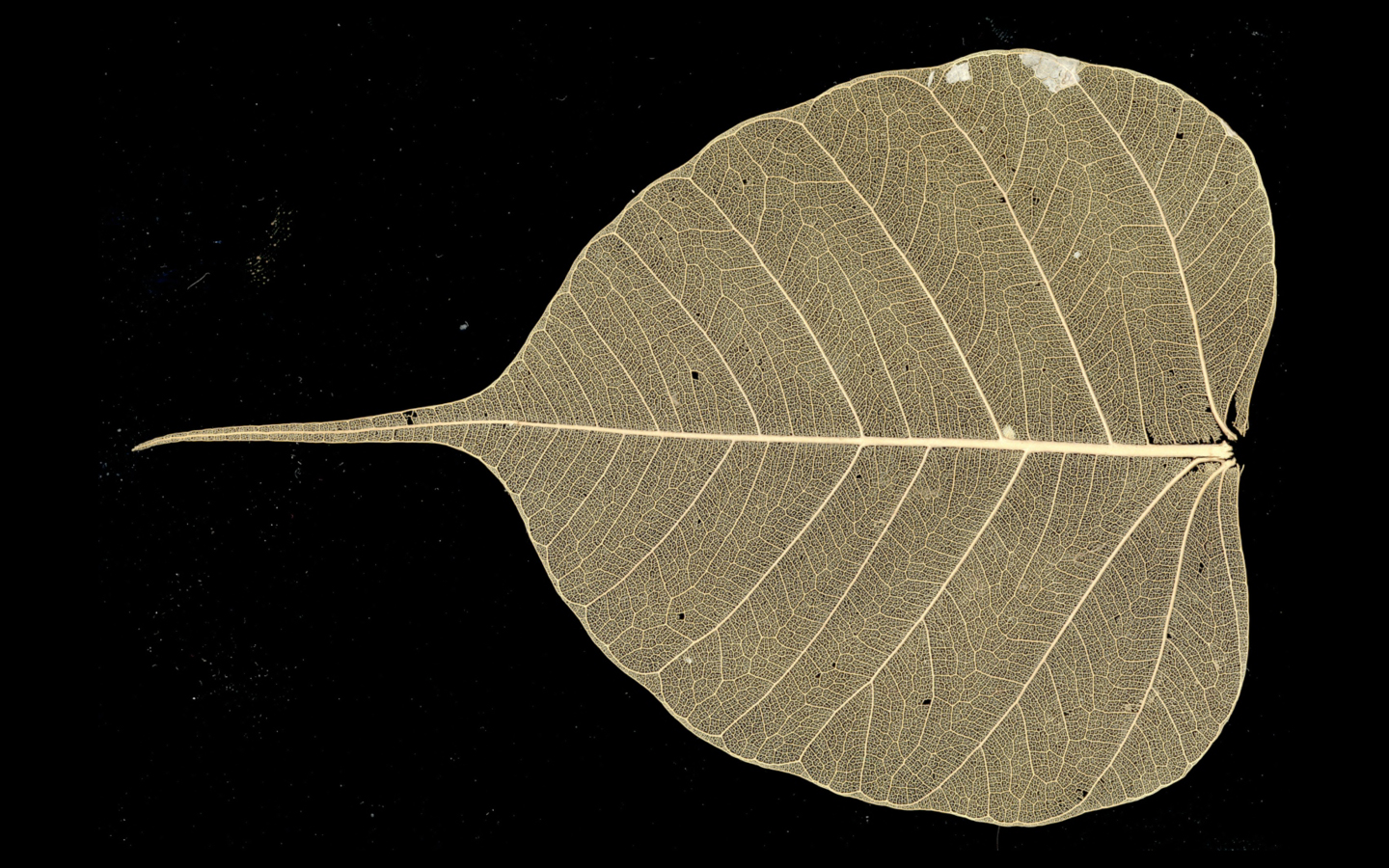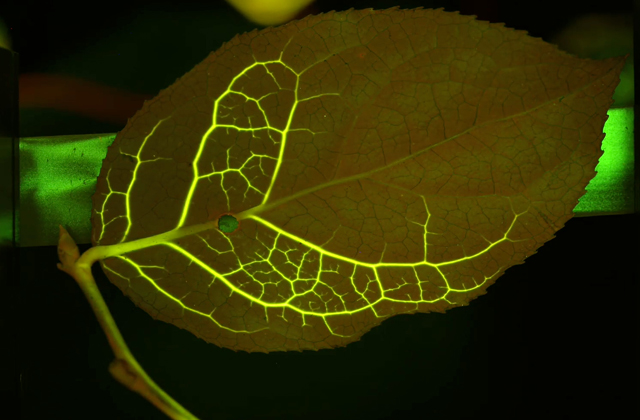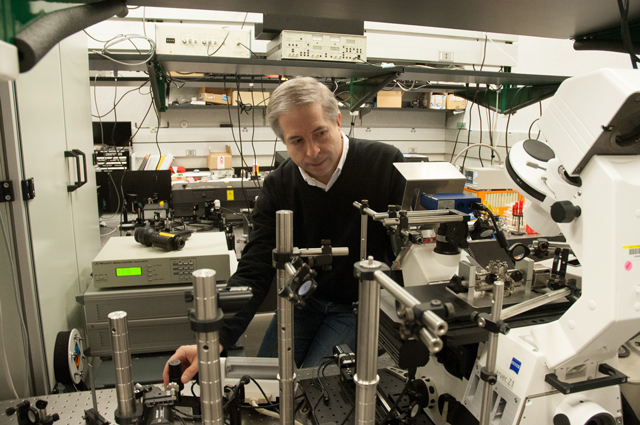In Natural Networks, Strength in Loops

Examine the delicate branching patterns on a leaf or a dragonfly’s wing and you’ll see a complex network of nested loops. This pattern can be found scattered throughout nature and structural engineering: in the brain’s cerebral vasculature, arrays of fungi living underground, the convoluted shape of a foraging slime mold and the metal bracings of the Eiffel Tower.
Loop architectures, like redundant computer networks or electrical grids, make structures resistant to damage. As Marcelo Magnasco, a physicist at Rockefeller University, points out, the Eiffel Tower is a clear example of loop construction, designed to maximize the distribution of strain across its recursive frame. But for all the natural examples of loop design, surprisingly little is known about why the networks in leaves and the cortical blood vessels are organized in this way.
“We understand the physics of the connections between entities in full, disgusting detail,” Magnasco said of simple circulatory systems. “Nevertheless, we do not understand the pattern as a whole. We don’t know why they look this way or why every tree is different.”
Over the past few years, Magnasco and others have begun to explore exactly why these patterns are so commonly found in nature. Studies on leaves and the brain’s vascular system have confirmed that nested loops provide a structure that is resistant to damage and that can efficiently deal with fluctuations in fluid flow. Now scientists are beginning to quantify the properties of these networks, gaining insight into their essential characteristics, such as resilience, and allowing for more informative comparisons between networks.
“Plants are a spectacular system to work on as physicist, because they are beautifully mathematical,” said Eleni Katifori, a physicist at the Max Planck Institute for Dynamics and Self-Organization, in Göttingen, Germany, who collaborates with Magnasco. Plants grow iteratively and frequently exhibit crystal-like patterns, such as the ones we see in pine cones and sunflowers, she said. “The hope is that if we understand the architecture of veins, we will get a better handle on photosynthetic efficiency in plants.”
Understanding leaf veins may also shed light on the vastly more complex vascular network on the surface of the brain, illuminating the close link between brain activity and blood flow. That relationship, while still poorly understood, provides the foundation for functional magnetic resonance imaging, one of the most popular brain imaging technologies in use today.
Mapping these networks may pinpoint parts of the brain that are particularly susceptible to stroke, and it could provide insight into the role of blood flow in Alzheimer’s disease and other cognitive problems. “You can imagine looking at diseased brains and trying to identify if any of those fundamental parameters are different and how it might relate to progression of the disease,” said David Boas, a physicist at Massachusetts General Hospital in Boston.
Because circulatory systems can be represented as a network of connected pipes, with well-known equations governing the flow of fluid, physicists can model simple networks like leaf veins with relative ease. By studying such systems, Magnasco hopes to uncover the reason for the size of the veins, the angles at which they connect and how structures of different scales in the network are put together.
Methods for analyzing easily visualized networks, Magnasco said, might then be applied to biological networks that are more difficult to model, such as webs of interacting genes and proteins or networks of neurons in the brain. Leaves are “a good option to study because the difficulties of the other network don’t exist,” said Magnasco.
To Build a Leaf
When it comes to creating an efficient network, evolution must consider two factors: the cost of building the network and the cost of operating it. For vasculature, this translates to the costs of making veins and pumping fluids through them. The cheapest network to operate is a simple branching tree structure, which is employed by some ancient plants. Though efficient, this structure is not very resilient. When a link is damaged, parts of the system suffer loss of fluid and die.

To try to understand the topology of vein architecture, Katifori and Magnasco built a simple network model trying to capture its essential features. They modeled the veins, called xylem, as a network of pipes with varying flow and pressure. Given limited amounts of pipe, they asked, how should the pipe be distributed to minimize drops in water pressure and to make the system as resilient as possible to damage? In the real world, “if an insect takes a bite out of a leaf, it keeps functioning,” said Katifori.
They found that an architecture of hierarchically nested loops — meaning loops within loops within loops — is most resistant to damage. “Loops make the network redundant,” said Katifori. “If you have damage, water can be rerouted to other channels.” The structures produced by the model, published last year in PLoS ONE, look very much like those in found in some leaves.
Striking videos of fluorescent fluid flowing through damaged leaves enabled the researchers to quantify how water flows around the site of damage. A leaf of ginko biloba, an evolutionarily ancient plant with a tree-like rather than a looped architecture, doesn’t exhibit the same resiliency.
The researchers also found that loop networks can better handle fluctuations in fluid flow as environmental conditions change.
Katifori and Magnasco are now modeling adaptive loop networks, which evolve in response to the changing environment and may be at play in fungi, slime mold and even the developing vascular system in animals. Slime mold, for example, constantly changes shape, extending long fingers, often in the form of a loopy network, in search of food. In one striking experiment, Japanese researchers grew slime mold on a surface dotted with oatmeal flakes arranged to mimic cities around Tokyo. The slime mold grew into a looped network resembling Tokyo’s efficient railway system.
Mapping Blood Vessels
Efficient blood flow is an essential component of the function of the brain, which lacks an extensive mechanism for energy storage: Electrically active neurons must be quickly replenished. As a result, the brain precisely regulates blood flow, increasing delivery to targeted regions. “That fine-tuning of blood flow happens on a very local level, likely way below the millimeter range,” said Bruno Weber, a neuroscientist at the University of Zurich.
More than a decade ago, David Kleinfeld, a physicist and neuroscientist at University of California, San Diego, and collaborators discovered that they could monitor blood flow in individual capillaries in the rodent brain. They found that blood flow often reversed direction, strongly suggesting that the network of vessels formed a looped structure. “There was a hunch that the vasculature was more interesting than I supposed at first,” said Kleinfeld.
Several years ago, Kleinfeld’s team discovered that the surface vasculature in the rat somatosensory cortex, a part of the brain that is active when the animal uses its whiskers to feel its way around the world, is organized in a random series of interconnected loops. This arrangement enables blood to flow to a specific spot from all directions, which enables neurons in that spot to get the fuel they need. “If loops are randomly connected in a two-dimensional lattice, blood can move radially to an electrically active spot,” said Kleinfeld.
In 2010, the researchers mapped out the vascular network covering the surface of the neocortex in rats and mice, the outer layer of the cerebral cortex. “We had a hunch it formed a mesh, so we completely filled the blood vessels and mapped the surface,” said Kleinfeld. “The bulk of the vessels were in a loop architecture.” Scientists had suspected some level of redundancy to the network, but Kleinfeld’s team provided a new level of detail. “We were the first to map the whole thing and come to grips with the topology — to quantify the network and use it to calculate flow,” said Kleinfeld.
The researchers used that connectivity map to run a computer simulation of what happens when a single vessel in the network was blocked. In both the model and the real brain, blocking a vessel in the two-dimensional lattice had little effect. The blood simply flows through other vessels. That finding is reflected in clinical practice: Strokes have never been detected on the surface of the brain. “Our conjecture is because it’s built this way,” said Kleinfeld.
Kleinfeld and collaborators then pushed deeper into the brain, examining the network of blood vessels that feed the neurons of the somatosensory cortex. In a paper published in Nature Neuroscience in July, the researchers showed that the capillaries form a continuous network. “This means that the microvessels — capillaries — are fully connected among each other,” said Kleinfeld. “There are no regions of isolated vessels, no gated communities in real estate terms.”
The researchers used a statistical mechanics approach called graph theory to understand the consequences of vessels that form networks with vertices with exactly three edges, which had been previously observed in the lab. (Here, “edges” refers to vessels.) Kleinfeld’s collaborator, UCSD physicist Harry Suhl, showed this to be a particularly robust architecture. “This is in contrast to graphs in which the number of edges per vertex is not fixed, as occurs on the Internet,” said Kleinfeld.
As in the surface network, blocking blood flow in the capillary system had little effect on the larger network — blood simply rerouted itself. However, blocking a penetrating vessel, which plunges from the surface of the cortex into the brain, has serious repercussions. Blood flow is blocked, and the surrounding brain tissue dies. Penetrating vessels are vulnerable to blockage because they don’t form loops, but Kleinfeld suspects the architecture provides an efficient means for redistributing blood to specific parts of the brain.
What this implies in clinical terms is not yet clear. Neurologists don’t report strokes that result from blockage of penetrating vessels, but that’s because the vessels are too small to see with typical brain imaging machines and individually would be unlikely to trigger symptoms. However, Geert Jan Biessels, a neurologist at the University Medical Center Utrecht, in the Netherlands, says that new, higher-powered brain imaging technologies are making it possible to detect very small lesions, though not yet at the resolution of the penetrating vessels themselves. He adds that evidence from brain autopsies suggests that such microstrokes “may be an important marker of cognitive decline and dementia in the years before death.”
Loops in the Brain
With their new tools for mapping the brain’s vasculature, Kleinfeld’s team plans to explore how the cerebral circulatory system can vary in rodents with specific mutations, or perhaps in other species. “Now we can start to look at different vasculatures and get some clue as to why things are built the way they are,” said Kleinfeld.
Preliminary examination of mice lacking an oxygen-sensing protein reveals a dramatically altered structure: Unlike typical animals, the mutant mice lack the two-dimensional lattice of vessels across the surface of the brain. “All you have is the 3-D structure,” said Kleinfeld. “It’s like a Rube Goldberg of little pipes.”
Weber and Kleinfeld are now collaborating on a project to map the entire vascular system in the mouse brain, an effort funded by the European Union’s Human Brain Project. Weber says the map will enable more accurate models and provide a helpful scaffold for the broader goal of mapping the entire brain. It will also allow researchers to look at whether parts of the brain that are prone to strokes, like the striatum, which is involved in motor planning, are vulnerable because of weakly interconnected vascular networks.
Researchers are also beginning to study circulatory networks in other parts of the body. Lance Munn, a biologist at Massachusetts General Hospital, said that most tissue has significant redundancy, in the form of loops. “In the skin, for example, these loops provide alternate routes for flow when injury occurs — flow can ‘go around’ to get to the tissue that is directly downstream from severed supply vessels,” he said. Munn is exploring the properties of vascular networks in tumors, which develop extensive networks of blood vessels to feed the growing cancer tissue. (A popular class of cancer drugs, angiogenesis inhibitors, stop tumors from growing by preventing new blood vessels from forming).
Kleinfeld is now using the tools developed for blood vessel networks to study neural networks in the brain stem, such as the sensorimotor loops that govern how rats move their whiskers and sense information. While “the vasculature is interesting in its own right,” said Kleinfeld, it also serves “as a warm-up exercise in part for nervous systems.”
This article was reprinted on ScientificAmerican.com.



